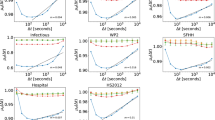Abstract
A link stream is a set of quadruplets (b, e, u, v) meaning that a link exists between u and v from time b to time e. Link streams model many real-world situations like contacts between individuals, connections between devices, and others. Much work is currently devoted to the generalization of classical graph and network concepts to link streams. We argue that the density is a valuable notion for understanding and characterizing links streams. We propose a method to capture specific groups of links that are structurally and temporally densely connected and show that they are meaningful for the description of link streams. To find such groups, we use classical graph community detection algorithms, and we assess obtained groups. We apply our method to several real-world contact traces (captured by sensors) and demonstrate the relevance of the obtained structures.











Similar content being viewed by others
Notes
Other community detection methods can be applied.
Candidates with one link represent 83 % of all candidates.
References
Ahn Y-Y, Bagrow JP, Lehmann S (2010) Link communities reveal multiscale complexity in networks. Nature 466(7307):761–764
Aynaud, T, Fleury E, Guillaume J-L, Wang Q (2013) Communities in evolving networks: definitions, detection, and analysis techniques. In: Mukherjee A, Choudhury M, Peruani F, Ganguly N, Mitra B (eds) Dynamics on and of Complex Networks, vol 2. Springer, New York pp 159–200
Balalau OD, Bonchi F, Chan T-HH, Gullo F, Sozio M (2015) Finding Subgraphs with maximum total density and limited overlap. In: Proceedings of the eighth ACM international conference on web search and data mining—WSDM ’15. ACM Press, New York, pp 379–388
Blondel VD, Guillaume J-L, Lambiotte R, Lefebvre E (2008) Fast unfolding of communities in large networks. J Stat Mech: Theory Exp 2008(10):P10008
Bogdanov P, Mongiovì M, Singh AK (2011) Mining heavy subgraphs in time-evolving networks. In: 2011 IEEE 11th international conference on data mining. IEEE, pp 81–90
Casteigts A, Flocchini P, Quattrociocchi W, Santoro N (2011) Time-varying graphs and dynamic networks. In: Lecture notes in computer science (including subseries lecture notes in artificial intelligence and lecture notes in bioinformatics), vol 6811. LNCS, pp 346–359
Cazabet R, Amblard F, Hanachi C (2010) Detection of overlapping communities in dynamical social networks. In: 2010 IEEE second international conference on social computing (SocialCom)
Crofoot MC, Kays RW, Wikelski M (2015) Data from: Shared decision-making drives collective movement in wild baboons. Movebank Data Repository. doi:10.5441/001/1.kn0816jn
Eagle N, Pentland AS, Lazer D (2009) Inferring social network structure using mobile phone data. PNAS 106(usually 1):15274–15278
Epasto A, Lattanzi S, Sozio M (may 2015) Efficient densest subgraph computation in evolving graphs. In: Proceedings of the 24th international conference on world wide web. International World Wide Web Conferences Steering Committee, pp 300–310
Falkowski T, Barth A, Spiliopoulou M (2007) DENGRAPH: a density-based community detection algorithm. In: Proceedings of the IEEE/WIC/ACM international conference on web intelligence, WI 2007. IEEE, pp 112–115
Falkowski T, Spiliopoulou M, Bartelheimer J (2006) Community dynamics mining. In: Proceedings of 14th European conference on information systems (ECIS 2006). Citeseer
Fournet J, Barrat A (2014) Contact patterns among high school students. PloS One 9(9):e107878
Gaumont N, Viard T, Fournier-S’niehotta R, Wang Q, Latapy M (2016) Analysis of the temporal and structural features of threads in a mailing-list. In: Cherifi H, Gonçalves B, Menezes R, Sinatra R (eds) Complex networks VII. Springer, Switzerland, pp 107–118
Greene D, Doyle D, Cunningham P (2010) Tracking the evolution of communities in dynamic social networks. In: 2010 International conference on advances in social networks analysis and mining (ASONAM), ASONAM ’10. IEEE Computer Society, Washington, pp 176–183
Hartmann T, Kappes A, Wagner D (2014) Clustering evolving networks. arXiv preprint arXiv:1401.3516
Holme P (2015) Modern temporal network theory: a colloquium. Eur Phys J B 88(9):234
Holme P, Saramäki J (eds) (2013) Temporal networks. Understanding complex systems. Springer, Berlin
Mitra B, Tabourier L, Roth C (2012) Intrinsically dynamic network communities. Comput Netw 56(3):1041–1053
Rozenshtein P, Tatti N, Gionis A (2014) Discovering dynamic communities in interaction networks. In: Calders T, Esposito F, Hüllermeier E, Meo R (eds) Machine learning and knowledge discovery in databases, vol 8725., Lecture notes in computer scienceSpringer, Berlin, pp 678–693
Samudrala R, Moult J (1998) A graph-theoretic algorithm for comparative modeling of protein structure. J Mol Biol 279(1):287–302
Saramäki J, Moro E (2015) From seconds to months: an overview of multi-scale dynamics of mobile telephone calls. Eur Phys J B 88(6):164
Sekara V, Stopczynski A, Lehmann S (2016) Fundamental structures of dynamic social networks. In: Proceedings of the national academy of sciences, p 201602803
Speidel L, Takaguchi T, Masuda N (2015) Community detection in directed acyclic graphs. Eur Phys J B 88(8):203
Strandburg-Peshkin A, Farine DR, Couzin ID, Crofoot MC (2015) Shared decision-making drives collective movement in wild baboons. Science 348(6241):1358–1361
Tournoux P-U, Leguay J, Benbadis F, Conan V, Dias de Amorim M, Whitbeck J (2009) The accordion phenomenon: analysis, characterization, and impact on DTN routing. In: IEEE INFOCOM 2009—the 28th conference on computer communications. IEEE, pp 1116–1124
Viard T, Latapy M (apr 2014) Identifying roles in an IP network with temporal and structural density. In: 2014 IEEE Conference on computer communications workshops (INFOCOM WKSHPS). IEEE, pp 801–806
Viard T, Latapy M, Magnien C (2016) Computing maximal cliques in link streams. Theor Comput Sci 609:245–252
Yang J, Leskovec J (feb 2013) Overlapping community detection at scale. In: Proceedings of the sixth ACM international conference on Web search and data mining—WSDM ’13. ACM Press, New York, p 587
Acknowledgments
This research was supported by a DGA-MRIS scholarship, by a grant from the French program “PIA-Usages, services et contenus innovants” under Grant Number 018062-44430 and by the CODDDE Project ANR-13-CORD-0017-01.
Author information
Authors and Affiliations
Corresponding author
Appendices
Rights and permissions
About this article
Cite this article
Gaumont, N., Magnien, C. & Latapy, M. Finding remarkably dense sequences of contacts in link streams. Soc. Netw. Anal. Min. 6, 87 (2016). https://doi.org/10.1007/s13278-016-0396-z
Received:
Revised:
Accepted:
Published:
DOI: https://doi.org/10.1007/s13278-016-0396-z



















